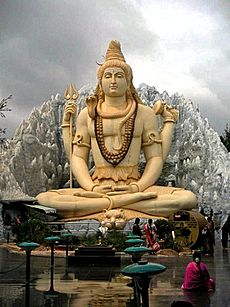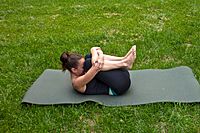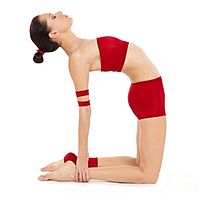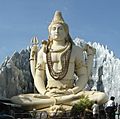Yoga facts for kids
Yoga is an old discipline from India. It is both spiritual and physical. Yoga uses breathing techniques, exercise and meditation. It helps to improve health and happiness. Yoga is the Sanskrit word for union. Patanjali was a pioneer of classical yoga. He defined yoga as "the cessation of the modification of the mind" (stopping changing the mind).
A person doing yoga will move from one posture (called asana) to another. For example, the "sun-salutation" contains 12 poses of asanas, one after the other, and is said to help balance body and soul. There is a specific mantra for each asana. The "sun-salutation" is popularly known as "Suryanamaskar".
Contents
History
Yoga was introduced by Indian Ascetic. Ascetic practices (tapas) are referenced in the Brāhmaṇas (900 to 500 BC), early commentaries on the Vedas. Several seals discovered at Indus Valley Civilization (~3300–1700 B.C.) sites in Pakistan depict figures in positions resembling a common yoga or meditation pose. The pose shows "a form of ritual discipline, suggesting a precursor of yoga", according to archaeologist Gregory Possehl. Scholars think there must be some type of connection between the Indus Valley seals and later yoga and meditation practices, though there is no conclusive evidence.
- Jonathan Mark Kenoyer describes one figure as "seated in yogic position".
- Karel Werner writes that " Archeological discoveries allow us therefore to speculate with some justification that a wide range of Yoga activities was already known to the people of pre-Aryan India".
Important yoga words(ashtang yoga)
- Yama: Positive Rules of meditations
- Niyama: Prohibitory Rules of meditations
- Asanas: Physical postures and movements
- Pranayama: Breathing techniques
- Pratyahara: Controlling the mind
- Dharana: Gazing inward
- Dhyana: Meditation with object
- Samadhi: Meditation without object
Types of yoga
- Classification based on mind and body.
- Rajayoga: Raja yoga focuses on meditation and contemplation in order to fully realize the self.
- Hathayoga: Hatha yoga is the practice of yoga postures, or asana, using the body as a vehicle for self-transformation.
- Classification based on way of spiritual life.
- Gyanyoga: It is a way of knowledge.
- Karmayoga: It is a way of work.
- Bhaktiyoga: It is a way of worship.
- Classification based on a way of other things.
- Swaryoga: Emphasizes the most on breathing.
- Kriyayoga: Emphasizes the most on blending Karmayoga (Tapa), Gyanyoga (Swadhyay) and Bhaktiyoga (Ishwar Pranidhan).
Some popular Yogasanas
A yogasana is a pose in which a person can sit. The intention of yogasana is to exercise the body and make it free of pains and problems.
Yogi is a person who has mastered yoga or has achieved great success in yoga. Yogasanas are also called Asana or Asanas (plural). A Yogi can sit in any asana for a given time.
- Pawanmuktasana
This yogasana helps to release gas in the stomach.
- Ushtrasana
This yogasana makes the spine more relaxed.
Images for kids
-
Statue of Shiva performing yogic meditation in Padmasana
-
Prince Siddhartha Gautama (the Buddha) shaves his hair and becomes a sramana (a wandering ascetic or seeker). Borobudur, 8th century
-
Traditional Hindu depiction of Patanjali as an avatar of the divine serpent Shesha
-
Asanga, a 4th-century CE scholar and a co-founder of the Yogacara ("Yoga practice") school of Mahayana Buddhism.
-
A sculpture of Gorakshanath, a celebrated 11th century yogi of Nath tradition and a major proponent of Hatha yoga
-
Swami Vivekananda in London in 1896
-
Sakyamuni Buddha in seated meditation with the dhyāna mudrā (meditation mudra), Gal Vihara, Sri Lanka.
See also
 In Spanish: Yoga para niños
In Spanish: Yoga para niños














